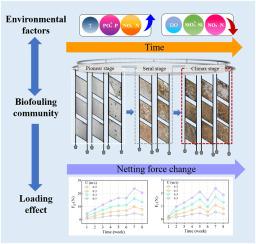西黄海近海养殖网箱生物膜群落结构及负荷效应
IF 5.3
1区 农林科学
Q1 AGRICULTURAL ENGINEERING
引用次数: 0
摘要
网上的生物结垢限制了网箱内水流的交换。这恶化了水生环境,增加了网箱负荷,威胁着养殖鱼类的健康和网箱结构的安全。本研究利用海上网箱网板,对不同水深(0.5、2.5和4.5 m)网箱上污染生物的群落演替进行了连续监测,探讨了污染生物群落与环境因子的关系。然后对收集到的脏网进行水动力试验。共鉴定出22个分类群,以活动种为主(54%)。在生物污染群落演替过程中,观察到近海网箱养殖显著的时空变化。平均丰度(~ 6.22 × 105个体m−2)、平均生物量(~ 985 g m−2)和平均净孔径遮挡百分比(~ 0.99)。Caprella aino (Caprellid)、Jassa mormorata (Gammaridea)和Tubularia mesembryanthemum (Hydroid)为优势种,其丰度与SiO32—Si浓度密切相关。污染生物群落的变化受温度(T)、溶解氧(DO)、盐度(S)、SiO32—Si、PO43—P和NO2—N的影响,其中T和SiO32—Si的影响最大。流体显著改变了网板的流体动力特性,使网板的最大阻力增加了6.09倍,最大升力增加了15倍。研究结果对海洋养殖网箱污染生物的防治和清除以及网箱结构的安全性评价具有重要的参考价值。本文章由计算机程序翻译,如有差异,请以英文原文为准。

Biofilm community structure and loading effect of netted cages for offshore aquaculture in the Western Yellow Sea
Biofouling on the netting limits the exchange of water flow within the net cage. This deteriorates the aquatic environment, increases the net cage load, and threatens the health of the farmed fish and the safety of the cage structure. In this study, we utilized net panels at offshore cage sites to continuously monitor the community succession of fouling organisms on netting at different water depths (0.5, 2.5, and 4.5 m), exploring the relationships between biofouling communities and environmental factors. The collected fouled nets were then subjected to hydrodynamic tests. In total, 22 taxa were identified, with motile species being predominant (54 %). Significant temporal and spatial variations in offshore cage cultures were observed in the succession of biofouling communities. The average abundance (∼6.22 × 105 individuals m−2), average biomass (∼985 g m−2), and average percentage net aperture occlusion (∼0.99). Caprella aino (Caprellid), Jassa mormorata (Gammaridea), and Tubularia mesembryanthemum (Hydroid) were the most dominant species, and their abundances were closely related to the concentration of SiO32--Si. Community changes in the fouling organisms were influenced by temperature (T), dissolved oxygen (DO), salinity (S), SiO32--Si, PO43--P, and NO2--N, with T and SiO32--Si having the greatest influence. Hydroids significantly altered the hydrodynamic properties of the net panels in terms of current, increasing the maximum drag on the net panels by 6.09 times and the maximum lift by 15 times. These results have significant reference value for preventing and removing fouling organisms in offshore aquaculture cages and for the safety assessment of cage structures.
求助全文
通过发布文献求助,成功后即可免费获取论文全文。
去求助
来源期刊

Biosystems Engineering
农林科学-农业工程
CiteScore
10.60
自引率
7.80%
发文量
239
审稿时长
53 days
期刊介绍:
Biosystems Engineering publishes research in engineering and the physical sciences that represent advances in understanding or modelling of the performance of biological systems for sustainable developments in land use and the environment, agriculture and amenity, bioproduction processes and the food chain. The subject matter of the journal reflects the wide range and interdisciplinary nature of research in engineering for biological systems.
 求助内容:
求助内容: 应助结果提醒方式:
应助结果提醒方式:


